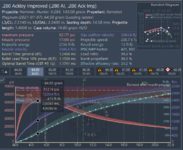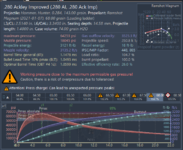hunter24605
Handloader
- Apr 30, 2016
- 2,756
- 5,162
Can someone help me understand. Maybe it’s how it’s worded, but I can’t wrap my head around it. I think what it is is a measure of how much energy is unused when the bullet exits the muzzle. Second question is, what is acceptable? I’m assuming the higher the better because when you increase barrel length the % goes up. I usually end up with somewhere between 25%~30% what’s confusing me is it’s calling it a ratio, but listed as a percent.
Effective efficiency:
The ratio of the kinetic energy contained at the muzzle in the projectile and the theoretically available energy of the powder mass used.
Effective efficiency:
The ratio of the kinetic energy contained at the muzzle in the projectile and the theoretically available energy of the powder mass used.
Last edited:








